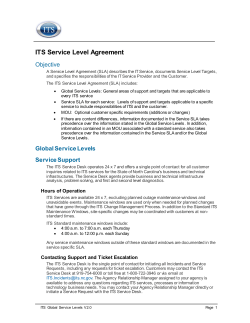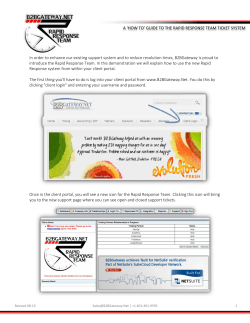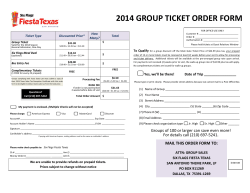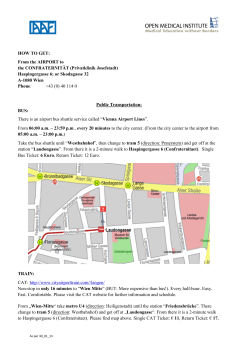
ITop 1.0 How To Don’ t hesitate to ask question at
ITop 1.0 How To Don’ t hesitate to ask question at support@combodo.com Table of content Table of content .......................................................................................................................... 2 Introduction ................................................................................................................................ 3 Step 1: Organizations, Locations, Teams and Contacts............................................................... 3 1. Creat e organizations .......................................................................................................... 3 2. Create locations .................................................................................................................. 3 3. Create persons .................................................................................................................... 3 4. Create teams....................................................................................................................... 3 Step 2 : CMDB ............................................................................................................................. 4 1. Create Infrastructure CIs ..................................................................................................... 4 2. Create softwares installed .................................................................................................. 4 Step 3 : Services Management................................................................................................... 4 1. Create services.................................................................................................................... 4 2. Create Sub services............................................................................................................. 4 3. Create SLT............................................................................................................................ 4 4. Create SLA ........................................................................................................................... 4 5. Create customer contract.................................................................................................... 5 Checking Incident & Service Request ......................................................................................... 5 Check customer ...................................................................................................................... 5 Check caller............................................................................................................................. 5 Check service .......................................................................................................................... 5 Check sub service ................................................................................................................... 5 Check workgroup .................................................................................................................... 6 Check agent ............................................................................................................................ 6 Checking Changes ....................................................................................................................... 6 Check customer ...................................................................................................................... 6 Check Requester ..................................................................................................................... 6 Check workgroup .................................................................................................................... 6 Check agent, supervisor and manager ................................................................................... 6 © Combodo 2010 2 Introduction The purpose of this document is to describe how to define objects in iTop step by step, in order to make sure that all the dependencies will work. As a matter of fact, when you create an object in iTop some fields have dependency on another object. That's why you need to make sure that the objects are created in a given order before using them. For instance, when you create an incident ticket, you need to make sure that the caller exists, that there is at least one contract documented for this customer defining services delivered by the support center. This document explains which order to follow for creating the objects, and what are the dependencies between iTop object. This document does not describe in details how to use iTop. For more details see “ iTop user guide” . Step 1: Organizations, Locations, Teams and Contacts 1. Creat e organizations After installing iTop you have one organization created by default “ My Company/ Department” . If you want to represent several departments or customers you have to create new organizations. This has to be done before creating all other objects as most of them are linked to an organization. 2. Create locations The locations are very useful for grouping object by geography. One location is linked to one and only one location. Even if the location attribute is not a mandatory field when you create a CI in CMDB, I would strongly recommend to create them before. 3. Create persons The persons are very important in iTop as they are used to define contacts and responsibilities. A person belong to one and only one organization. I would recommend to create them before the teams. 4. Create teams The teams are linked to several types of object like contracts, tickets in order to define responsibilities. You have to make sure that the teams exists before creating tickets, contracts, user requests. It is also mandatory to have at least one persons linked to a given team as a member. Else when you will create a ticket, you won't be able to assign it to an agent. The attribute “ Role”is not mandatory, so you can leave it empty. © Combodo 2010 3 Step 2 : CMDB The purpose of this chapter is to describe the dependencies between Cis in the CMDB. 1. Create Infrastructure CIs You can easily create Network devices, Server, Personal Computers, Printers and Mobile Phone as soon as your organizations and locations are created. 2. Create softwares installed Before creating the softwares installed on an infrastructure, you have to define list of standard application known in iTop. This is done via menu —Data Administration Applications”. You need as well to create the Licences if you wan to manage them but it is not mandatory. Once done, you can create the softwares installed on an infrastructure. The attribute “ device”depends on the selected owner organization, the attribute software is the list of applications you have created in —Data Administration Applications「 Step 3 : Services Management This step is really mandatory if you plan to use Incident and Service Request objects. As a matter of fact, they use services and contracts to define categories for grouping, as well as to define default work groups responsible for handling the ticket. To create services and customer contracts, I would strongly recommend to apply following process: 1. Create services This is the first step you need to achieve. Without services you won't be able to create customer contract. 2. Create Sub services Once a service is created you can define sub services that are linked to this service. This is mandatory for creating an incident or an user request ticket related to a service. 3. Create SLT The service level targets (SLT) defines metrics that are used in computing automatically if service level agreement (SLA) are met or not when managing an incident or a use request. If you want to use this feature in iTop you have to define them, before creating the SLAs. 4. Create SLA The SLAs are used to define what agreement has been signed with a customer for a given contract. Itop uses them to find which SLT are applicable for a given customer when it computes color code and escalation deadline for incident and service request tickets. If the SLA are not defined, this computation won't be made. © Combodo 2010 4 Once the SLA is define you can link it to already defined SLTs 5. Create customer contract Once you have created a service with sub services, SLTs and SLAs you can create a customer contract for this service. The contract is linked to a given service via the associated SLAs. You can define several SLAs for a given customer contract. If no SLAs are defined, iTop won't know to which service it is related to, and won't be able to use it in Incident Management and Helpdesk modules. Moreover, you have to select a support team belonging to the provider. The team is used to define the workgroup responsible for the service in the incident and user request tickets. If not set you won't be able to create ticket. Checking Incident & Service Request This chapter describes what need to be checked when creating an incident or a user request. If you have not followed previous steps, you may encounter issues when creating an incident or a user request ticket. As a matter of fact, some mandatory attributes depends on other object, and if they are not defined, you won't be able to create the ticket. Check customer The customer attributes is the first one to select when you create a ticket. As a matter of fact, the caller, service, sub service and workgroup attributes depend on it. Check caller If the list is empty, it means that there is no person define for the selected customer. This is describe in Step1. Check service The attribute service depends on the selected customer and the contracts defined for this customer. If there is no contract defined for the selected customer the service list will be empty. Moreover, even if there is a contract defined, but no SLAs are linked to this contract, the service list will be empty. So has described in Step3, before creating incident or user request tickets for a given customer., make sure you have defined at least one contract with at least one SLA for it. Check sub service The attribute sub service depends on the selected service. If you have not define sub service for it in Step3, the list will be empty and you won't be able to create the ticket. © Combodo 2010 5 Check workgroup The workgroup attribute depends on the selected service and related contract signed for the selected customer. You will see in workgroup list all teams defined in contracts that are linked to the selected service via a SLA. If no SLA are set, or if no team is defined in related contract, the workgroup list will be empty and you won't be able to create a ticket. Check agent When you want to assign an incident or a user request you have to update the corresponding attribute. This one depends on the selected workgroup. As workgroup are teams, if the corresponding team as no member, the agent list will be empty and you won't be able to create the ticket. So make sure that all teams used when you create customer contracts have at least one member defined. Checking Changes This chapter describes what need to be checked when creating a new change. If you have not followed previous steps, you may encounter issues when creating a change ticket. As a matter of fact, some mandatory attributes depends on other object, and if they are not defined, you won't be able to create the ticket. Check customer The customer attributes is the first one to select when you create a change ticket. As a matter of fact, the requester attribute depend on it. Check Requester If the list for selecting is empty, it means that there is no person define for the selected customer. This is describe in Step1. Check workgroup If there is no teams defined in iTop, the workgroup, supervisor team, and manager team list will be empty. So make sure you have at least 1 team defined in iTop for creating a change ticket. Check agent, supervisor and manager The agent list depends on the workgroup team. So if there is no member in this team, the list will be empty. The supervisor list depends on the supervisor team. So if there is no member in this team, the list will be empty. The manager list depends on the manager team. So if there is no member in this team, the list will be empty. © Combodo 2010 6
© Copyright 2025











